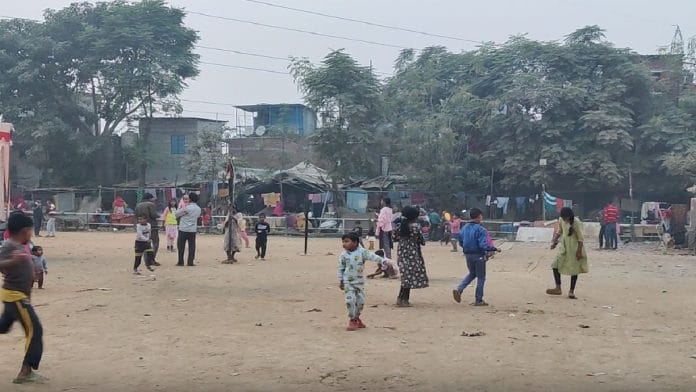New Delhi: A one-room house in Seelampur is now doubling up as a classroom for two teenagers after the Delhi government moved classes online due to hazardous air pollution that has gripped the national capital over the past two weeks. While 13-year-old Vidhi Utwal sat on the corner of a queen-sized bed, wearing headphones as she attended her social science class, her father, seated nearby, watched TV news about the Maharashtra election, on full volume. To the right, her 15-year-old sister performed puja. She had to miss her online classes.
The family has just one smartphone. Amid this cacophony, Sheetal Utwal, Vidhi’s mother, is preparing their morning tea on a stove.
On a typical day, this house feels a bit emptier, as Vidhi and her sister are usually at school.
While the two sisters struggle to attend their classes inside the one-bedroom house in Seelampur, many Delhi children from poorer backgrounds can be seen roaming and playing in the slums without masks. The Delhi government’s plan for keeping children safe isn’t exactly working the way it was supposed to.
“I prefer studying at school because there are fewer distractions, and I can communicate with my teachers and friends. It’s difficult for me to study on this small phone screen,” said Vidhi, a student of Pili Building Senior Secondary School, Seelampur.
For those living life on the margins, it’s not toxic air that is their biggest enemy. It’s their daily reality and poverty.
“We live in front of an open sewer and a garbage dump. Pollution is a small problem for us to worry about — there are much bigger issues we face every day,” said 54-year-old Uma Singh, as she swept the area in front of her house in Seelampur.

Also read: Delhi NCR RWAs are the new pollution crusaders. If only govt would give them timely answers
Online classes mean holiday
In Masoodpur’s Jai Hind Camp in South Delhi, a large group of children of varying ages can be seen playing in an open field. Some parents sit nearby, discussing the ongoing issue of water scarcity, while others talk about the challenges they face during online classes. For most students in the slum, the school closure feels more like a holiday—a chance to play and have fun all day. Some of them even don’t know why the schools are closed.
For 10-year-old Ruhaana Khatoon and 9-year-old Ayaan Miya, who attend MCD Primary School in Masoodpur, any day without school is always a day for playing and hanging out in the neighbourhood.
“Sir (teacher) comes into the school WhatsApp group and says there’s no internet connection, so he can’t take any online classes. No school means no study,” said Ruhaana Khatoon, a 5th-grade student.
Ruhaana’s mother Rehana Bibi too said that school is always better than online classes because her children don’t listen to her and haven’t studied for days now. MCD Primary School in Masoodpur has not been holding online classes for the past three days due to internet issues on the teachers’ side, Rehana Bibi added.

“We work the whole day outside and can’t always keep an eye on the children’s studies. Plus, online classes aren’t happening; teachers just send some work to the group and ask them to complete it and send it back,” said 30-year-old Rehana Bibi.
Sanju Singh, who has been living in Seelampur for nearly 20 years, has three children studying in the nearby government school, in third, fifth, and eighth grade. However, the family has just one smartphone. If one child attends their online class, the others have to miss theirs.

On Monday, the Central Pollution Control Board (CPCB) recorded “severe” AQI levels at Anand Vihar (487), Chandni Chowk (444), IGI Airport-T3 (494), and Dwarka (499). In response to the worsening air quality in the capital, the Commission for Air Quality Management (CAQM) implemented stage 4 of the Graded Response Action Plan (GRAP) on Sunday.
Struggling teachers
As for teachers of government schools, the online classes are a reminder of the pandemic days. And ensuring attendance and fighting a patchy internet connection is their biggest challenge.
“We even have to come to school to conduct these classes, and on top of that, it’s always difficult to manage 30 to 40 students virtually,” a government school teacher told ThePrint on the condition of anonymity.
Slow internet connectivity is another cause of concern for teachers who are using personal devices to connect to a classroom of 40-odd students. They use Zoom and WhatsApp to assign homework to students. Since there is no WiFi in the school, teachers use their phone internet. Usage of phone and laptop together causes delayed buffering, frozen screens and classes are frequently disconnected.
“Sometimes, we have to call students to remind them to attend classes, and the connectivity issues always make it difficult for everyone, as we are also using our personal devices. There is no additional help from the government or authorities,” the teacher added.
In November 2023 too, Delhi’s schools were closed for several days due to the rising air pollution in the city, and classes were shifted to online mode. The same happened the year before. However, the challenges surrounding online classes haven’t been addressed yet.
Standing outside her home in the Anna Nagar slum at ITO, 17-year-old Pinki Pal just wants to go back to school, as she cannot join online classes due to the lack of a smartphone at home. There’s only one smartphone in her household and her father, who works as an auto driver, uses it.
“I just hope the school opens soon and as for the pollution they can make mask-wearing compulsory because I’m not able to get any updates or information about the school,” said Pinki.
(Edited by Anurag Chaubey)






